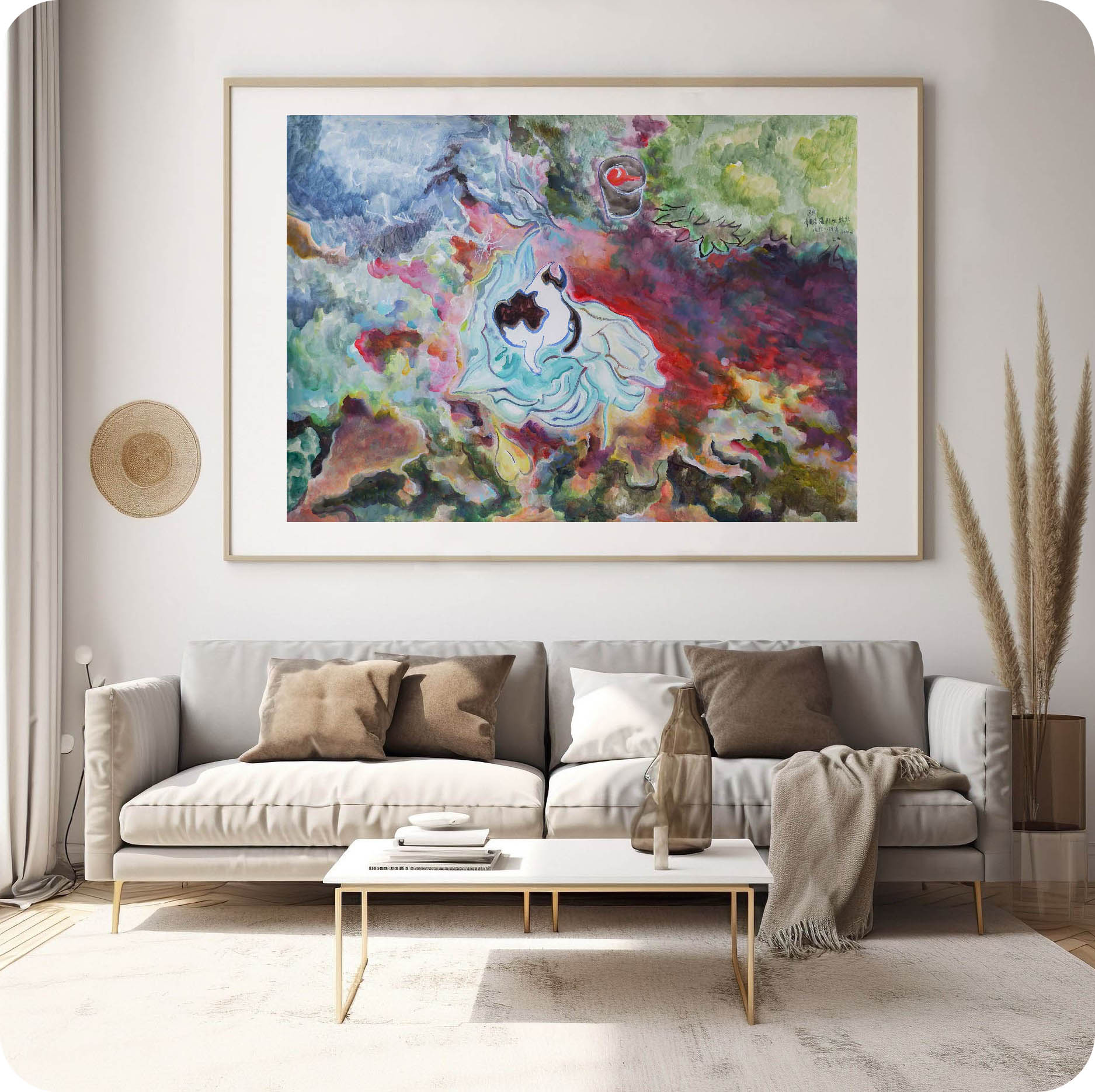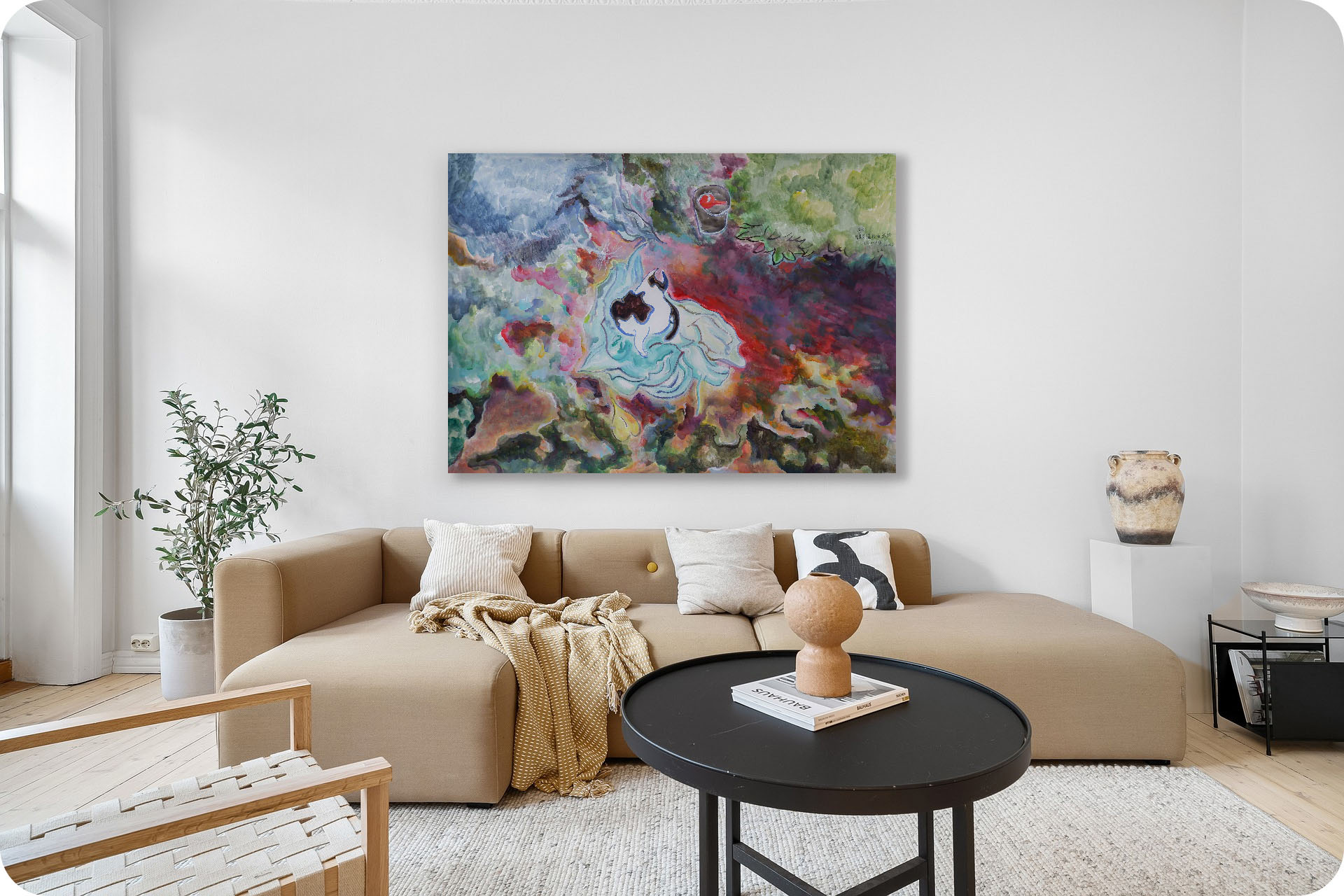This painting was created in 2024. The colors of this year are still bright but not dazzling. I have gradually found a balance point among the bright colors.
A cat in the back mountain licked its hair amid the overlapping memories. It had no idea why humans were so slow.
Inches: x in
Size without the frame: x cm
Country: China
Date: 2024
Materials: Acrylic paint on paper.
Condition: well preserved
Creative themes and style | My works revolve around the creative concept of "The land of humanity, People on the land".The people in the painting are people in nature, and the lines, shapes, and colors are close to nature. The nature in the painting is nature in the eyes of humans, existing in interaction with humans.I don’t pursue a series of works with a fixed and continuous style. I hope that the style of the pictures will synchronize with the changes in my life and always remain oscillating. The performance of the work must be in sync with the development of one's own life in order to be Sincere and powerful.Ideas are later.
An Interview with Artist Philo by Artphiloso Gallery
If you would like to collect this artwork or know more about the artist, please contact us.


Composition and Overall Mood
This painting unfolds like a visual dream, where abstract forms, symbolic figures, and expressive color fields intertwine. The central motif—a cat resting upon ripple-like forms—is set against a background of flowing, blended hues, creating a dialogue between the figurative and the abstract. The overall impression is that of a poetic meditation on nature, memory, and emotion.
Color and Technique
The artist employs a wet-on-wet technique, allowing blue, green, red, and purple tones to bleed and merge seamlessly. This creates a fluid, chaotic, yet harmonious background reminiscent of a river in constant motion. The effect mirrors the flow of emotions and thoughts, suggesting that the canvas itself becomes a vessel where inner experience and outer nature converge.
Symbolism of Forms
At the center, the cat and ripple-like contours function as emotional carriers. Their intertwining presence suggests playfulness, intimacy, and a sense of dependence on nature’s nourishment. Above them, the bucket with a red object introduces a concrete symbol within the otherwise abstract environment. It implies the act of “irrigation”—both literal and metaphorical—signifying the nourishment of rivers, emotions, and spiritual life.
Surreal Expression and Poetic Narrative
Through a surrealist approach, the painting disrupts conventional logic by fusing natural elements, life symbols, and dreamlike imagery. The disordered yet organic flow of color becomes a metaphor for the unceasing movement of inner thought, while the freely expanding forms echo the idea of “frequently flowing” rivers. This duality transforms irrigation from a physical act into a symbol of emotional and spiritual sustenance, completing a poetic monologue about guardianship, dependence, and care.
Artistic Significance
This painting illustrates the emotional materialization of color—each blended tone and wandering line reflects a reverence for nature and an appeal for nourishment of the soul. It demonstrates how art, by transforming personal emotion into symbolic form, can reveal the hidden connections between humans and nature, memory and reality, desire and care.
Marc Chagall, I and the Village
Known for its dreamlike colors and surreal juxtapositions, creating a poetic vision of memory and imagination.
Joan Miró, Harlequin’s Carnival
Explores symbolic forms and fluid color rhythms, embodying playful fantasy and subconscious imagery.
Sanyu, Cat in Flowers
Uses simple lines and soft tonalities to convey intimacy and tenderness, resonant with the cat motif in this painting.
Paul Klee, The Path to Paradise
Employs abstract patterns and luminous colors to build a dreamlike spiritual landscape.
The cat’s body is defined by simple black-and-white outlines, which makes it striking against the vibrant and complex background. Sitting calmly atop what resembles flowing waves or petals, it becomes the visual focal point of the entire composition, conveying both tranquility and liveliness.
Though these are ordinary household objects, their placement beside the cat and amidst the fluid colors suggests an act of “watering and nourishment.” This symbolism connects with the title of the artwork, evoking a poetic sense that “someone is watering the river of life for me.”
The background employs free watercolor-style washes and layered blending of hues, creating a visual tension where rivers, soil, and plants seem to interweave. This technique gives the piece both the organic textures of nature and the dreamlike qualities of imagination.
This painting belongs to the genre of symbolic imagery painting. By combining the figurative symbol of the black-and-white cat with the bucket, ladle, and abstract color fields, the artist creates a surreal narrative space. It is especially well-suited for display in a study, art gallery, or cultural venue, where it helps establish a poetic and contemplative atmosphere.
As a contemporary canvas painting that merges abstraction with imagery, its value lies not only in the purity of the cat’s form and the symbolism of the objects, but also in the artist’s distinctive color language. Works of this kind hold strong appeal for private collections and art investment, carrying both aesthetic and cultural significance within the contemporary art market.
A: Click here to view ARTPHILOSO's Guide for Collectors.
